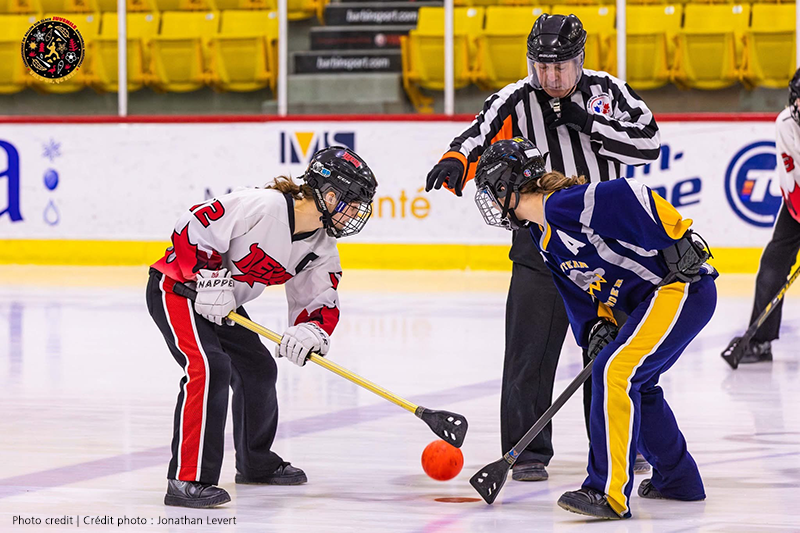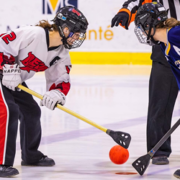Breaking the Mold: Broomball Canada’s Long-Term Development Evolution

In the world of Canadian sport development, Broomball Canada stands as a compelling success story of evolution and adaptation. Working in partnership with Sport for Life, they’ve transformed their Long-Term Development (LTD) framework from a traditional model in 2009 to an innovative, inclusive system that better serves athletes and communities across the country. Their journey offers valuable lessons for all National Sport Organizations (NSOs) looking to modernize their approach to athlete development.
A Brief Introduction to Broomball
Broomball is a winter ice sport played in hockey-like arenas where players use specialized “brooms” (actually specialized sticks with molded ends) to maneuver a small ball into the opponent’s net. Players typically wear special rubber-soled shoes for traction rather than skates. The sport combines elements of hockey and soccer, requiring teamwork, coordination, and strategic play. With organized leagues across Canada, broomball has developed a passionate community of players who value both the competitive and social aspects of the game.
The Evolution Journey: 2009 to 2024
When Broomball Canada published its first LTD model in 2009, it represented the best understanding of athlete development at the time. The five-stage model followed the “10 Key Factors” that were standard for long-term athlete development programs. Fast-forward to 2024, and we see a transformed approach that embodies the philosophy of continuous improvement in action.
Broomball Canada embraces the philosophy of continuous improvement in their updated framework, recognizing that continuous improvement is essential for significant future impacts. This commitment to evolution resulted in a comprehensive revision based on new scientific research, evolving sport practices, and direct feedback from the broomball community across Canada.
Key Transformations That Made the Difference
1. From Exclusion to Inclusion
Perhaps the most significant shift has been in the overall philosophy. The 2009 model, like many traditional sport frameworks, was built around concepts that naturally selected athletes through various stages of development.
The 2024 model explicitly moves away from this approach. The updated LTD model incorporates several significant changes to better meet the needs of today’s athletes, emphasizing a more inclusive approach that ensures equity and diversity. It shifts from a system that cuts and excludes participants to one that includes everyone and assists those who may not be achieving the experience they desire by helping them find appropriate pathways.
This inclusivity manifests in two key ways: by promoting equity and diversity in recruitment and retention and by providing athletes with a clearer understanding of the player pathway—an important element that was absent in the initial framework.
A key advantage of the broomball system is its accessibility regardless of age. Unlike sports such as hockey, where beginning after age 11 makes finding appropriate beginner programs extremely difficult for youth, broomball allows you to start playing at any age and find a good program for you. This approach removes barriers to entry that exist in many other sports.
This transformation aligns with Sport for Life’s vision of creating paths for all participants, whether they’re pursuing excellence or active participation for life.
2. From Age-Based to Development-Based
The original framework relied on chronological age as the primary determinant for programming. While it acknowledged developmental considerations, the new model makes this a centrepiece of the approach.
The revised model continues to support moving from age-based programs suitable for the average participant to stage-of-development-appropriate participation for all. This shift recognizes the wide variation in physical, mental, and emotional development among participants of the same age, creating more effective and personalized pathways for all athletes.
3. From Winning to Learning
Competition remains vital in sport, but how it’s structured and emphasized has evolved significantly. The 2009 model discussed competition structures by stage but maintained traditional approaches to winning and competitive outcomes.
The 2024 framework explicitly transitions from focusing on wins and standings to facilitating meaningful competition where learning is prioritized. This fundamental shift creates environments where athletes at all levels can develop skills through appropriate challenges without the pressure of scoreboard results dominating the experience.
4. From Physical Activity to Physical Literacy
While both models emphasize physical development, the updated framework expands this concept across the lifespan. The emphasis has shifted from purely physical activity to developing physical literacy across the lifespan, from preschoolers to seniors.
This holistic approach ensures that participants develop not just the physical skills for broomball but the fundamental movement abilities, confidence, and motivation to engage in physical activity throughout their lives—a core principle of Sport for Life’s philosophy.
5. From Silos to Systems
The 2009 document acknowledged the importance of system alignment but didn’t fully address how to create seamless pathways from grassroots to elite levels. The updated model fosters collaboration across all levels within the sport, from grassroots to World Championship teams, to maximize benefits, reduce overlaps, and provide athletes with a clear, unified pathway to achieving their sporting goals.
This systems approach creates more efficient resource use and clearer pathways for participants, coaches, and administrators throughout the broomball community.
Building Blocks of Successful Transformation
Broomball Canada’s successful evolution didn’t happen by chance. Several key strategies facilitated this transformation:
1. Evidence-Based Approach
The updated model embraces Evidence-informed Continuous Improvement as one of its guiding principles. In the rapidly evolving realm of technology and research, new data from studies can swiftly influence our understanding of sports. The framework highlights the importance of staying current with research and incorporating new findings into practice.
The organization implemented specific methodologies such as:
- Regular review cycles of their framework against the latest sport science
- Monitoring athlete development trends across all stages
- Collecting data on program effectiveness and participant experience
- Adjusting training approaches based on evidence rather than tradition
2. Community Feedback and Co-Creation
A crucial element was direct engagement with the broomball community. A new survey of broomball players across the nation provided fresh perspectives on the challenges they face and their reasons for staying in the sport. This bottom-up approach ensured the framework addressed real needs rather than theoretical ideals.
3. Guided Partnership with Sport for Life
Working with Sport for Life provided the expertise and framework to guide this transformation while respecting the unique aspects of broomball culture. This partnership allowed Broomball Canada to benefit from broader sport development knowledge while applying it appropriately to their specific context.
Tyler Lang, Sport for Life’s Manager of Quality Sport, said: “Broomball Canada’s commitment to reimagining their LTD framework exemplifies what’s possible when a sport organization embraces both evidence and inclusion. Their willingness to challenge traditional approaches while respecting the unique culture of their sport has resulted in a model that truly serves athletes at all stages of development. We’ve been proud to support their journey and believe their approach sets a standard for other NSOs to follow.”
Real-World Impact of Framework Changes
The transformation of Broomball Canada’s LTD model has led to tangible changes in how programs are implemented across the country:
Program Implementation
The shift from age-based to development-based programming has resulted in more flexible approaches where athletes can develop at appropriate paces. The framework emphasizes meeting participants where they are developmentally rather than solely by chronological age, which creates more personalized development pathways for each athlete.
Another important advancement in the updated framework is the expansion of the skill matrix to consider all positions, not just players in possession of the ball. This comprehensive approach to skill development ensures that participants develop their abilities, whether they have the ball or not—a crucial aspect of team sports that is often overlooked in traditional development models.
Competition Structure
The emphasis on meaningful competition over winning has transformed how competition is viewed within the development model. The framework explicitly promotes competition structures that prioritize learning and development over standings and results, especially in the foundational stages.
Coach Development
The framework changes have cascaded into coach education approaches. The LTD pathway clearly outlines what coaches should focus on at each development stage, from emphasizing fun and fundamental movement in early stages to more advanced tactical and mental preparation in later stages.
Pathway Clarity
The new framework has created clearer pathways for participants, allowing them to see how they can progress through the sport whether their goals are recreational participation or high performance. The document explicitly acknowledges that Broomball is a sport that can be entered at any age, with the seven-stage pathway providing guidance regardless of when someone joins the sport.
This approach carefully distinguishes between accessible entry points for newcomers and structured pursuit points for those who want to perform at higher levels, creating a comprehensive pathway system that serves athletes with varying ambitions.
The framework’s multi-sport approach recognizes complementary activities like gymnastics, lacrosse, and ball hockey as beneficial for developing skills that transfer to broomball, particularly during early developmental stages.
Addressing Future Challenges
The updated framework also acknowledges the challenges facing broomball and outlines key areas for future development:
- Leadership – Creating volunteer recognition opportunities and succession planning
- Facilities – Increasing accessibility to facilities and exploring options like outdoor rinks
- Coach and Referee Development – Advancing recruitment and retention programs
- Competition – Providing safe and inclusive environments to compete
- Athlete Development – Developing more programs for each stage of the LTD
These strategic priorities directly address the barriers identified through their player surveys and community consultations, demonstrating a commitment to continuous improvement.
Joe D’Eramo, Manager of Quality Sport, said: “The ADM takes a holistic approach, ensuring athlete development extends beyond moments of ball possession. By incorporating all four domains—physical, technical-tactical, mental, and social—it fosters well-rounded athletes and enhances key intangibles such as broomball IQ.”
The Road Ahead: A Model for Other NSOs
Broomball Canada’s journey offers valuable insights for other National Sport Organizations considering similar transformations:
- Embrace the process: Meaningful change takes time and requires a commitment to continuous improvement.
- Engage your community: Those participating in your sport provide the most valuable insights for improving your framework.
- Partner with experts: Collaborations with organizations like Sport for Life provide valuable guidance and proven methodologies.
- Balance tradition and innovation: Honour what makes your sport unique while embracing new approaches to development.
- Focus on inclusion: Creating pathways for all participants strengthens your sport at every level.
The results speak for themselves. Broomball Canada has created a more inclusive, developmentally appropriate, and systematic approach to player development that serves participants at all levels and ages. Their revised framework provides a roadmap not just for broomball’s future but for other sports looking to evolve their development models.
As Sport for Life continues to partner with National Sport Organizations across Canada, Broomball Canada’s successful transformation stands as a powerful example of what’s possible when sport organizations commit to evolution, inclusion, and evidence-based approaches to player development.
Ultimately, this holistic approach aims to create a Canadian sport system that is both good for sport and good for society—a worthy goal for every sport in our nation.

